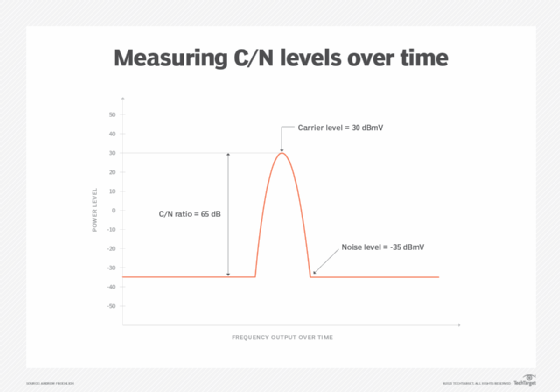carrier-to-noise ratio
What is a carrier-to-noise ratio?
In communications, the carrier-to-noise ratio, often written as CNR or C/N, is a measure of the received carrier strength relative to the strength of the received noise. High C/N ratios provide better quality of reception, and generally higher communications accuracy and reliability, than low C/N ratios.
Too much noise introduced into a signal can cause the receiving device to be unable to differentiate noise from the actual signal being sent. Because C/N is calculated as a form of digital transmission, high C/N ratios are an indication of low bit error rates from one end of the digital communication to the other.
How is CNR calculated?
Engineers specify the C/N ratio in decibels between the power in the carrier of the desired signal power and the total received noise power. If the incoming carrier strength in microwatts is Pc and the noise level, also in microwatts, is Pn, then the carrier-to-noise ratio in decibels is determined using the following formula:
C/N = 10 log10(Pc/Pn)
Mathematically, the C/N ratio is measured in a similar way as the signal-to-noise ratio (S/N), and both specifications indicate the quality of a communication channel. For the most part, the S/N ratio specification is more meaningful in practical situations, including measuring the signal-to-relative noise of twisted-pair copper cabling, Wi-Fi and LTE/5G. The C/N ratio is commonly used for measuring the amount of noise received in satellite communications systems or point-to-point microwave shots. The calculation can be performed multiple times to help accurately position or align the receiving dish. The better the C/N ratio is, the better aligned the satellite dish is relative to the incoming signal.
C/N ratios can be mapped over time using a graph that measures signal power received against frequency signal output over time. The following example shows a signal strength peak at 30 decibel milliwatts (dBm) with a noise floor of -35 dBm. Thus, the C/N ratio is the difference between these two signal strengths.

What is the difference between CNR and SNR?
Unlike S/N, which is calculated prior to digitized modulation, C/N is calculated post-modulation. This is where the term carrier comes from. Digitally modulated signals are comprised of two continuous waveforms called carriers. These are known as carrier signals and are what sets digital C/N ratios apart from analog S/N ratio calculations. Examples of digital modulation methods include amplitude-shift keying, frequency-shift keying, phase-shift keying and quadrature amplitude modulation.
When a C/N ratio is calculated, it pulls data from output from the antenna transmitting the signal along with what the antenna on the other end received. This contrasts with S/N, which pulls information prior to being demodulated onto the transmitter side and when it is demodulated on the receiving side. So, C/N calculates the noise temperature only while in transit, while S/N calculates both the transmission noise and any noise picked up during the modulation or demodulation process.
Learn which industries will benefit the most from 5G and what effects this will have on businesses and consumers.







